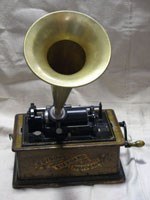
NPS Photo In 1885, Thomas Edison wrote, "I have not heard a bird sing since I was twelve." No one is really sure just how Edison lost most of his hearing. Yet this man invented the first machine that could capture sound and play it back. In fact, the phonograph was his favorite invention. The first phonograph was invented in 1877 at the Menlo Park lab. A piece of tin-foil was wrapped around the cylinder in the middle. You shouted a short message into the piece on one side of the cylinder while you turned the handle. Inside this piece was a needle. Your voice would make the needle shake, or vibrate. The sound vibrations would go through the needle and make a line, or groove, into the tin-foil. A needle on the other side could play back what you had just recorded. After just a few plays, the tin-foil would tear up and the message could no longer be played. That is why the tin-foil recordings cannot be played anymore. Later phonographs played records. The first ones were in the shape of a cylinder, with the music on the outside. Later records were shaped like discs, or large CDs. Edison loved the phonograph so much that he called it his "baby". He improved it over and over for the next fifty years.
Back to the Electric Light System Motion Pictures |
Last updated: February 26, 2015
